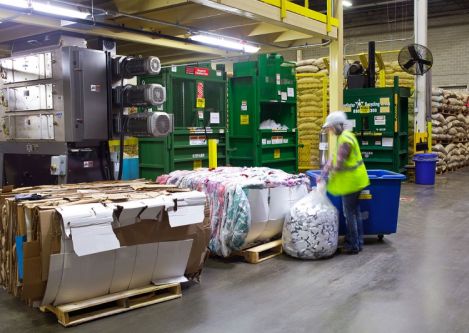SEATTLE, 2015-3-25 — /EPR Retail News/ — One of the largest coffee roasting plants in the world has achieved its target of being a “100% Landfill Diversion” facility, due to Starbucks partners (employees) who led the effort. The accomplishment, certified by Underwriters Laboratories, means that all of the waste produced on site is either recycled or reused and nothing is sent to landfills.
More than 400 Starbucks partners work in two buildings in York, Pennsylvania. Each covers about 450,000 square feet – one is the coffee roasting plant, the other is Starbucks largest distribution center.
“The facility was always proactive about recycling, but I realized that wasn’t good enough when I visited a company that supplied our packaging film in 2009 and saw that they weren’t sending any waste to a landfill,” said Denise Wills, senior sustainability and maintenance coordinator for Starbucks York plant. “We made it our mission to do the same at York.”
Wills created a spreadsheet to track where the waste streams were within the York facility, then systematically worked with vendors to recycle and reuse the waste. She tracked down, to the pound, how much waste was being sent to landfills. Behaviors changed, Wills said, when people were able to see how much was being diverted from different areas of the plant.
In 2012, York Partners pulled together and formed a recycling committee made up of partners from every department in the facility to accomplish the goal of recycling “every cup, every piece of plastic, every shred of cardboard – everything,” said Haskell Allen, director of Safety, Health and Environment for Starbucks Global Supply Chain.
The York team realized that finding local vendors who could use the recycled materials was the easier part of the plant-wide effort. The bigger challenge was changing recycling behaviors.
“Every site was doing some type of recycling, that’s nothing new,” Allen said. “What we did was track the waste and engage partners in creating the culture and discipline needed to push for our aggressive recycling goals.”
Starbucks York Roasting Plant received the UL certification for being a 100% Landfill Diversion facility in May of 2014. Since then, Starbucks partners in York have continued to find ways to recycle even the smallest items, such as ear plugs.
Transforming, Not Trashing
Starbucks® Stores around the world have also found creative ways to transform recyclable paper products.
One example is found at a Starbucks location in Bogota, Colombia’s bustling neighborhood of Chico Norte – home to international embassies, banks, and global businesses. Starbucks senior designer Hannelore Freer created a striking wall-to-ceiling installation, made with used napkins, cups, newspapers and packing boxes sourced from Starbucks stores in Santiago.
The installation, made up of more than 140 (12in x 24in) large diamond shaped tiles. The lightweight, sustainable tiles provide sound absorption and match the store’s color palette. Each tile is mounted to the wall and ceiling with the help of a strong magnet and rod, lending the installation a light, mobile feel.
“When we came across this material, I knew we could do something special with it” said Freer. “Each piece is light, airy and seems to float, reminding me of a coffee tree leaf blowing in a light harvest breeze.”
Working with the local Colombian government, Starbucks also helped introduce a recycling program that will increase environmental awareness in El Peñol, Guatapé community. With five new waste collection centers and a multi-tiered educational campaign on the importance of recycling, 1,160 people – from grade school students to educators and parents – and learning how to reduce their environmental impact.
Recycled Stores
In some cases, entire Starbucks® stores are made from recycled materials. Recognizing that its own supply chain relied on shipping containers to transport coffee and tea, Starbucks wanted to find a way to reconfigure containers near the end of their usable life spans into drive-thru stores. This innovative thinking has led to several 450 square foot stores, each made from four shipping containers, since 2012.
Read more and share your input:
Starbucks 2014 Global Responsibility Report
Starbucks.com/responsibility
For more information on this news release, contact the Starbucks Newsroom.
###
